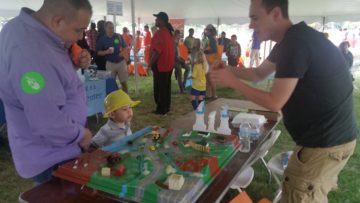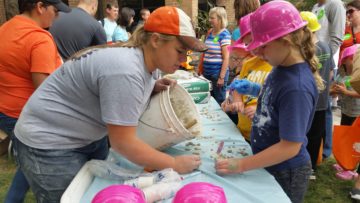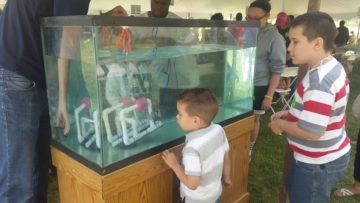By JAN LARSON McLAUGHLIN
BG Independent News
Learning can be pretty loud and messy. Just ask the kids covered in foam bubbles. Or the kids making concrete. Or the ones building rockets.
For the seventh year in a row, a whole lot of learning masqueraded as fun at STEM in the Park at Bowling Green State University on Saturday.
“We want to make learning fun and we want to spark interest in the STEM fields” of science, technology, engineering and math, said Jenna Pollock, coordinator of the event organized by the Northwest Ohio Center for Excellence in STEM Education.

Kids learn about lizards and snakes.
An estimated 5,000 grade school kids, their parents and volunteers showed up to play. All the events were hands-on, with the messier ones relegated to the outside. There was a “Cootie Camp,” where kids could enter a black tent to get a peek at the germs covering them. There was a giant foam machine shooting foamy bubbles all over kids. There was a sloth and a vulture from the Toledo Zoo.
And yes, before you ask, this is education – just in a sneaky form.
“We do make it fun,” Pollock said. “They are learning without thinking they are learning.”
One outside tent was devoted completely to water issues. Children – and in some cases, their inquisitive parents – got to use a remotely operated vehicle, similar to those used by oceanographers to study shipwrecks and coral reefs that are too deep for divers to venture.
“They go places man cannot,” explained Matt Debelak, of the Greater Cleveland Aquarium.

Children learn about erosion in watersheds.
Another display showed kids about erosion in watersheds. Powdered hot chocolate represented the dirt, powdered Kool-Aid represented pesticides. As the young scientists sprayed water onto the “terrain,” they could see how rain sends soil and pesticides into waterways.
At a nearby display, dirt and roots were turned into a lesson on how plants can hang onto nutrients and water. “They are really into shaking the jars of dirt,” said Jessica Wilbarger, of the Lucas Soil & Water Conservation District. “They’re really impressed when the water reaches to bottom,” following along roots that extended about two feet deep.
One of the hot spots of the STEM event was the foam pit, where an endless stream of bubbly foam was shooting out at kids. Jodi Recker, of Spark Enriched Classes for Children, called it a “sensory extravaganza.” Next to the foam pit was a “bubble pond,” where kids dipped hoops and created giant bubbles.

Children create giant bubbles.
“We are not constrained by a test,” Recker said. “We are here digging in, taking it to the kids’ level.”
Kids were learning about the surface tension of bubbles and how foam is formed. “We are helping kids see that learning is for our whole lifetime,” she said. And experiments are good – whether they are successful or not. “You won’t know until you do it.”
At the construction area, kids were pulling on ropes to see how pulleys make it easier to lift weight. They also got to make “concrete popsicles,” that set up in about 15 minutes.
“It’s about as fast of a concrete lesson as we can do,” said Scott Gross, an instructor with the BGSU Construction Management program.

Children create concrete popsicles.
Inside the Perry Field House, other experiments were taking place. Kids were looking through virtual reality goggles, and were learning how to use the magic of magnets to make items move.
In one corner, a giant parrot from the Toledo Zoo was being coached to sing to its young audience. Elsewhere, kids were learning about organ donations, green screen technology, and how to help small plastic soldiers parachute safely to the ground.
“I’ve done a lot of experiments,” said Dominic Stegman, 14, of Sylvania. The STEM event “definitely” made science more fun, he added. He was carrying evidence of his favorite lesson so far – a tube rocket. “It’s engineering, putting all the parts to work,” he said.
Out on the track in the field house, kids were learning the science behind batteries, how solar power works, secrets to the skeletal system, and how to hold a lizard.
Nothing boring here.
“This is helping people realize how fun science can be,” said Bob Midden, director of the Northwest Ohio Center for Excellence in STEM Education.

Children operate remote control underwater vehicle.
STEM education can be found in music, art, athletics and animals. “It’s only the human mind that divides the world into disciplines,” Midden said.
The program is also intended to show kids and parents that through learning, the world can be made a better place. “We can make valuable contributions to our world as well,” he said.
All the activities, plus the lunches, were free at the STEM in the Park. Area educational institutions, private companies, and non-profit organizations came together to make it possible, Midden said.

